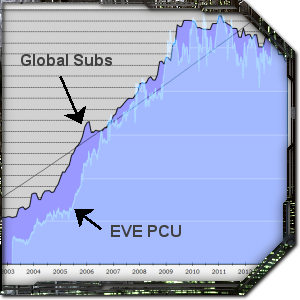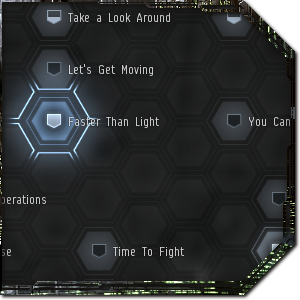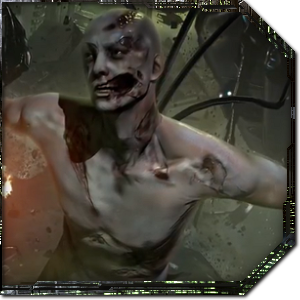
When I started writing about EVE Online for Massively back in 2008, the MMO genre was really hitting its stride, and emerging sites like Massively were starting to attract quite a bit of traffic. I was a young Computer Science student and massive EVE fanatic with just a few magazine articles and an amateur blog under my belt, equal parts excited to expose my favourite game to a wider audience and apprehensive about screwing it up. I cautiously penned my first EVE Evolved piece on April 27th 2008, a critical think-piece that set the tone for much of the column’s tenure. Now seven years and over 320 articles later, I’m very glad that EVE Evolved is still here to dish out a regular dose of insight into the often impenetrable world of EVE Online.
I think it’s safe to say that this has been one of the most interesting years in the column’s lifetime, especially with Massively shutting down back in February and the staff striking out on our own as independent MMO news site MassivelyOP. It’s been an equally interesting year for the MMO genre, with indications of paid subscriptions dropping across the board and EVE Online showing its first year of non-consecutive growth. As EVE approaches its 12th birthday next week, it’s worth looking back on some of the year’s highlights. We’ve seen the impact of EVE switching from two major expansions per year to ten smaller releases, a ton of improvements for new players, the exciting resurgence of the 2009 Sleeper storyline, and there’s the promise of a complete nullsec overhaul just around the corner.
In this anniversary edition of EVE Evolved, I look back at the past year of the EVE Evolved column and highlights from EVE‘s 12th year!
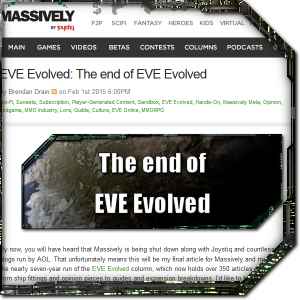 MassivelyOP’s launch and Fanfest 2015
MassivelyOP’s launch and Fanfest 2015
Just a few months ago, we got the news that Massively was closing down with virtually no notice. For a time it seemed that many of the staff’s journalistic journeys were coming to an abrupt and unjust end. A few of the team were snapped up for other jobs, but most of us decided to pull together and launch our own independent site. Thanks to the generous contributions of readers to our Kickstarter campaign (and Bree putting in an insane amount of work), Massively Overpowered was born and columns like this one have been thankfully able to continue with the minimum of interruption.
The closure came at something of a bad time for EVE coverage, with the budget to cover EVE Fanfest 2015 suddenly pulled from under our feet. CCP surprisingly offered to pay for my flights and accommodation for the event even before the new site was announced, and I was told that CCP really values my opinions and wanted me there even if I produced no coverage of the event at all. In the end, MassivelyOP was up and running in time for Fanfest and we formalised a new ethics policy that allows us to accept flights and accomodation to approved events as long as we fully disclose all of it in the event coverage. As a result, we got some great coverage of Fanfest 2015!
We managed to find out that Project Legion may be stuck in development limbo while developers iterate on DUST 514 and saw an interesting shift in CCP’s priorities toward VR, with an impressive EVE: Valkyrie demo on the Crescent Bay Oculus Rift and four new experimental VR tech demos. We also heard about the impressive plans to add fully customisable structures and player-built stargates to EVE Online in the near future as part of the ongoing work to revitalise territorial control and warfare. I was very critical of CCP’s sovereignty revamp plans in an article before Fanfest, but seeing the structure overhaul rolled into it certainly made me revaluate that position.
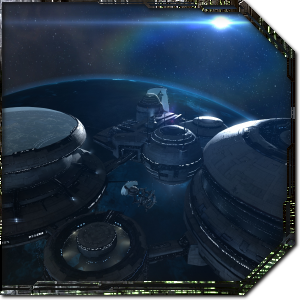 The faster release cycle really works
The faster release cycle really works
This year has been something of an experiment for EVE Online, as it switched from a strict schedule of two major expansions per year to deploying around 10 smaller releases in the same timeframe. I was initially skeptical of the change, arguing that expansion names were extremely important for co-ordinating media coverage and getting players hyped to resubscribe for a dose of something fresh every six months. While there’s some debate to be had over the effect this has had on player activity or subscriptions, there’s no doubt that this new schedule has been a huge success for EVE‘s gameplay. Features now come out fully working and polished, and fixes have been applied in a timely manner rather than being delayed for up to six months.
There was initially worry that this schedule would lead to only smaller features being worked on, but several massive updates have blown that idea out of the water. We got a complete revamp of the industrial gameplay and user interface with the Kronos and Crius releases, and Oceanus added everything from new PvE missions and a handy notification system to a complete rebalancing of all modules to remove unnecessary module tiers. The massive Rhea update in December added the first tech 3 destroyer, 100 new wormhole star systems, and a unique wormhole hub system called Thera designed to be the Mos Eisley of EVE. At EVE Fanfest 2015, Executive Producer Andie Nordgren showed that more features, bugfixes and content were released in this past year than in any previous year.
It’s kind of odd to be praising EVE for its success with this year’s releases while at the same time looking at its slightly disappointing player activity graphs. Although CCP was touting year-on-year subscriber growth as late as February 2014, it had already become clear by then that EVE‘s player activity had plateaued for the past few years. This slipped into a definite downward trend later in the year, and I investigated the problem in October 2014, initially placing much of the blame on factors like the political stagnation in EVE‘s lawless nullsec regions and the decreased time today’s older gamers have to play.
More recently, player extrapolations have showed that EVE‘s subscriptions may have dropped by around 18% in the past two years, indicating that the downward trend is not limited only to player activity but also to purchasing decisions. In trying to assess the validity of the 18% drop figure, I found that the entire paid subscription model for MMOs may actually be on the decline and EVE could simply shrinking with the market. This would mean EVE actually bucked a significant downward market trend in 2013 and 2014, perhaps due to PLEX and the very positive reception of updates over that period. While there are no plans for EVE to switch out of the subscription model, CCP has been recently spreading out into alternate revenue streams like selling ship skins and focusing on new games like EVE: Valkyrie.
A number of this year’s updates have made EVE far more accessible for new players. Corporations have been given the ability to switch off intra-corp PvP, a mechanism normally used by infiltrators to gank unsuspecting players. With the fear of infiltration removed, many corps are now hiring newbies again! The skill queue has been changed to infinite length to help newcomers train new skills without logging in every single day. Cloning costs and skill point penalties on death were also completely removed from the game, making cheap disposable ships highly cost-effective in all forms of PvP.
A new Opportunities system recently replaced EVE‘s standard tutorial with an interesting achievement-like approach that has proven much more effective at getting new players into the game. The coming months will see a complete revamp of the corporation mechanics to make corps easier for new players to form, and this summer’s sovereignty overhaul should help open up territorial warfare and nullsec PvP to much smaller organisations. This year I also looked at how various quality of life improvements had improved wormhole expeditions, and started a discussion on four things EVE does right that other sandbox games should take note of.
Though it’s easy to think of the year’s updates as simply a series of patches, content releases and mechanical changes, this was the first year when I felt EVE‘s own core storyline truly came alive. Previous years have shocked and amazed us with the occasional tale of thousands of players clashing over some remote star system or a ferengi-like player swindling other players out of hundreds of billions of ISK, but this year’s NPC Sleeper storyline held me spellbound in a way that none of those could.
Things kicked off when a mysterious star appeared in the night sky, and players noticed that it got brighter the closer they got to Jove space. The star turned out to be a massive supernova in the heart of Jove space, which knocked almost all the stargates in the region offline and opened tears into previously unseen wormhole systems. Not long after, Sleeper ships began flying around empire space and scanning everything in sight. They found and decloaked mysterious structures spread throughout the galaxy, which turned out to be long-lost Jove observatories put in place to keep an eye on us. The story took a very sinister turn when the Sleepers began dismantling the Jove observatories and harvesting our corpses for spare parts. It emerged that the Sleepers had found a way to rebuild their bodies, and they’re now planning an invasion of our space.
What really struck me about these stories is that they didn’t just happen in news articles and blog posts. They actually happened in-game and consequently spread like wildfire through social networks, in-game communities, and chat channels. CCP even reported on each new development with a short in-character news clip from in-game news channel The Scope. All of this brought me back to when I first started playing EVE and spent weeks reading the game’s official scientific articles and fictional chronicles. The advancing of the 2009 Sleeper storyline both in fiction and actual in-game mechanics made me feel as if I was living through one of those chronicles, and that’s a powerful notion.
 It’s been a year filled with contradictions for both EVE Online and the EVE Evolved column. The column almost came to an abrupt end with the closure of Massively, only to be resurrected through the generosity of our readers. EVE itself seems to be shrinking in subscribers despite developers having done a fantastic job improving and overhauling the game. CCP even released more and bigger features under the its new frequent update paradigm than it had for years in its major expansions. And while the player stories that typically dominated the media slowed down this year, I’ll always remember this as the year that the NPC storylines really kicked off again.
It’s been a year filled with contradictions for both EVE Online and the EVE Evolved column. The column almost came to an abrupt end with the closure of Massively, only to be resurrected through the generosity of our readers. EVE itself seems to be shrinking in subscribers despite developers having done a fantastic job improving and overhauling the game. CCP even released more and bigger features under the its new frequent update paradigm than it had for years in its major expansions. And while the player stories that typically dominated the media slowed down this year, I’ll always remember this as the year that the NPC storylines really kicked off again.
As EVE heads into its 13th year of operation, there’s a lot to be hopeful about. The game is becoming more approachable and accessible to new players with each new update, and we have game-changing sovereignty and structure overhauls on the horizon to help give people a place in the world and a sense of ownership of it. We’re sure to get new PvE content too as the Sleeper story progresses, and if we’re lucky we may even get some entirely new forms of PvE gameplay to chew on. While subscription numbers could be on a decline and CCP is certainly seeking alternate revenue streams, it’s clear that EVE Online is still the company’s number one focus. The coming year will certainly be an interesting one for EVE and CCP, and I’m glad to be here to write about it at MassivelyOP.
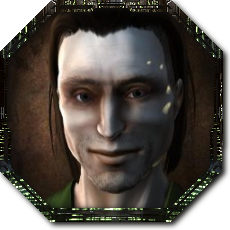 EVE Online expert Brendan ‘Nyphur’ Drain has been playing EVE for over a decade and writing the regular EVE Evolved column since 2008. The column covers everything from in-depth EVE guides and news breakdowns to game design discussions and opinion pieces. If there’s a topic you’d love to see covered, drop him a comment or send mail to brendan@massivelyop.com!
EVE Online expert Brendan ‘Nyphur’ Drain has been playing EVE for over a decade and writing the regular EVE Evolved column since 2008. The column covers everything from in-depth EVE guides and news breakdowns to game design discussions and opinion pieces. If there’s a topic you’d love to see covered, drop him a comment or send mail to brendan@massivelyop.com!
